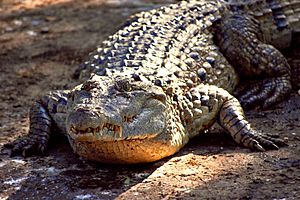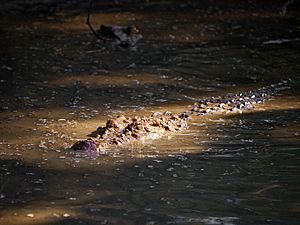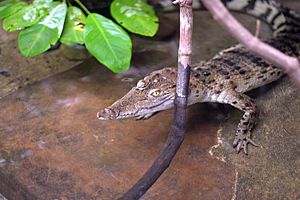Philippine crocodile facts for kids
Quick facts for kids Philippine crocodile |
|
|---|---|
 |
|
| An adult Crocodylus mindorensis basking | |
| Conservation status | |
| Scientific classification | |
| Genus: |
Crocodylus
|
| Species: |
mindorensis
|
 |
|
| Range of the Philippine crocodile in blue | |
The Philippine crocodile (Crocodylus mindorensis) is a special type of crocodile found only in the Philippines. It's also known as the Mindoro crocodile or the Philippine freshwater crocodile. Local names include bukarot in Ilocano and buwaya in many Filipino cultures.
This crocodile is one of two types found in the Philippines. The other is the much bigger saltwater crocodile (Crocodylus porosus). The Philippine crocodile is unique to the country. Sadly, its numbers have dropped a lot. It went from being "data deficient" to "critically endangered" by 2008. This happened because of too much hunting and harmful fishing methods, like using dynamite.
Groups like the Dutch/Filipino Mabuwaya foundation and the Crocodile Conservation Society are working to protect these animals. It is against the law to kill a crocodile in the Philippines, and you can be punished for it.
Contents
About the Philippine Crocodile
How Scientists Name Them
Scientists group living things using a system called taxonomy. This helps them understand how different animals are related. Until 1989, the Philippine crocodile was thought to be a type of New Guinea crocodile (Crocodylus novaeguineae). But now, scientists know it's its own unique species.
What They Look Like
The Philippine crocodile is a freshwater crocodile. This means it lives in rivers and lakes, not the ocean. It's quite small compared to other crocodiles. It has a wide snout and thick, bony plates on its back. These plates are like natural armor.
Both male and female crocodiles can start having babies when they are about 1.5 meters (5 feet) long and weigh around 15 kilograms (33 pounds). They can grow up to 3.1 meters (10 feet) long. Females are usually a bit smaller than males. Young Philippine crocodiles are golden-brown. As they get older, their color becomes darker.
Where They Live
The Philippine crocodile used to live in many parts of the Philippines. But now, they are gone from places like Samar, Jolo, Negros, Masbate, and Busuanga.
You can still find small groups of them in certain areas. These include the Northern Sierra Madre Natural Park in Luzon rainforest, San Mariano, Isabela, and Dalupiri island in the Babuyan Islands. They also live in Abra (province) in Luzon, and in Ligawasan Marsh, Lake Sebu in South Cotabato, and Pulangi River in Bukidnon. There might also be some in the Agusan Marsh Wildlife Sanctuary in Mindanao.
These crocodiles play an important role in their environment. They often eat sick fish, which helps keep the fish population healthy. By eating the most common fish, they also help balance the different types of fish in the water. Plus, crocodile droppings are good for fish because they add important nutrients to the water.
Protecting the Philippine Crocodile
Crocodylus mindorensis is one of the most endangered crocodile species in the world. The IUCN, a group that tracks endangered animals, lists it as "critically endangered." Experts believe there are fewer than 100 adult crocodiles left in the wild.
This species used to be found all over the Philippines. But now, its numbers are very low. We don't know much about how they live or how they interact with the larger saltwater crocodile, which lives in some of the same areas. More studies are needed to find out exactly where they are now.
The main reason their numbers dropped was hunting for their skin. Today, the biggest threat is that their homes are being destroyed. People are clearing land for farming to feed a growing population.
Helping Them Survive
The government doesn't always have enough support for crocodile protection. Local people sometimes kill crocodiles because they don't understand them. Many people think crocodiles are dangerous man-eaters. But in reality, the Philippine crocodile is small and usually won't attack people unless it feels threatened.
It's important to teach people about these crocodiles. Awareness programs can help change how people view them. In some areas, like northeast Luzon, groups are working with local communities. They want people and crocodiles to live together peacefully.
One way to help is through "captive breeding." This means raising crocodiles in special centers and then releasing them into the wild. The Crocodile Rehabilitation Observance and Conservation (CROC) project does this. Silliman University and other international centers also help.
In 1992, it was thought that fewer than 1000 Philippine crocodiles were left in the wild. By 1995, that number was updated to no more than 100 adult crocodiles. Baby crocodiles are usually not counted because many don't survive.
In 2007, a group of experts in the Philippines started working together to save crocodiles. The Crocodile Conservation Society Philippines and the Zoological Institute of HerpaWorld are running programs to breed and release them.
The Philippine crocodile was once thought to be gone from northern Luzon. But in 1999, a live crocodile was found in San Mariano, Isabela. This crocodile, named 'Isabela', was cared for by the CROC project. It was released back into the wild in August 2007. At that time, it was 1.6 meters (5.2 feet) long.
Laws Protecting Crocodiles
In 2001, the Philippine crocodile became protected by law. This was through Republic Act 9147, also known as the Wildlife Act. If you kill a crocodile, you can be fined up to ₱100,000 (about $2,500). In 2012, the Philippine Senate also introduced a resolution to make these laws even stronger.
Crocodiles in Media
The Philippine crocodile has been shown on TV. It was featured in National Geographic's Dangerous Encounters. In one episode, Dr. Brady Barr, a crocodile expert, tried to see all the crocodile species in the world. He was lucky enough to see a two-week-old Philippine crocodile.
The hatching of a Philippine crocodile was also filmed by GMA News for their show Born to Be Wild. They also showed how tropical fire ants, which are not native to the area, eat unhatched crocodile eggs. The TV team even saved a nest from a fire ant attack. They also filmed adult Philippine crocodiles.
Crocodiles in Stories and Beliefs
Ancient Tagalog people had special beliefs about crocodiles. They thought that after someone died, their soul would be carried to the afterlife by a buwaya. This buwaya was seen as a crocodile monster with tough skin and a tomb on its back.
Even though these buwayas were considered sacred, people also feared them. They believed the buwaya could attack living people, trap them in its tomb, and take their soul to the land of the dead. Because they were so sacred, killing a buwaya was a very serious crime, punishable by death.
See also
 In Spanish: Cocodrilo de Mindoro para niños
In Spanish: Cocodrilo de Mindoro para niños




